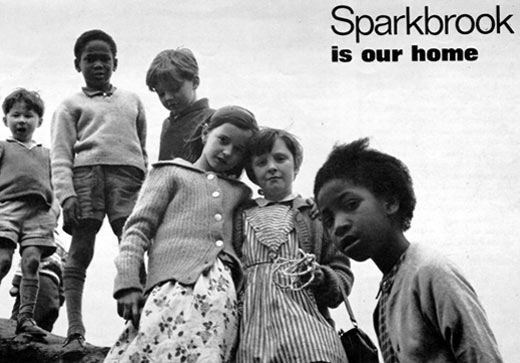
Origins
Formed in 1960 as a voluntary, non-party-political and non-sectarian organisation, the Sparkbrook Association aimed to promote the 'well-being' of the Sparkbrook community. In terms of campaigning for social justice, the Sparkbrook Association's activity was centred on the provision of services and facilities which were intended to bring about an improvement in social conditions rather than political-based activism or consciousness-raising. In this respect, it provides an interesting contrast with the work of the Indian Workers' Association.
The Sparkbrook Association came about as a result of the concerns of various professionals, including doctors and social workers, councillors and local residents who wanted to address what they saw as a physical decline in the local area. Sparkbrook had been labelled a 'Twilight Zone' because it was an area that suffered from poor housing and overcrowded multi-occupancy, at the same time as becoming home to many new migrants from the Caribbean, Pakistan and India. Whilst immigration debates raging in British politics were concerned with stemming the flow of migrants, it was felt by many that something needed to be done about the problematic living conditions facing those who had already migrated.
After a couple of meetings the Sparkbrook Association was formed- residents now had a crucial forum through which they could express their concerns and take collective action. Key figures in the development of the Sparkbrook Association included the Rev Jack Reed, vicar of Christ Church and the Association's first Chair; Dr Mary Barrow, Vice-Chair and later Chair of the Association; Mr Albrecht Turk, the Association's Director; Donald Curtis, Organiser and Elizabeth Tompkins, the Association's general purpose social worker and its first paid employee.
Aims
The aim of the organisation was:
"To promote the well-being of the Community resident in the Sparkbrook area of the City of Birmingham, and its immediate neighbourhood by associating the Local Authority, the Churches, voluntary youth and adult organisations and residents in a common effort to further health and advance education".
It was recognised that partnerships would need to be formed in order to accomplish projects which had the potential to bring real change to the lives of local residents. The professional expertise, social positioning and connections that a number of members were able to benefit from facilitated this way of working which was vital to achieving their ends.
As well as focusing on health and education, the Sparkbrook Association was also intended to provide a meeting place and facilities for "recreational, social moral and intellectual development" and to foster community spirit.
Activities
The main activities carried out by the Sparkbrook Association included:
- the creation of the first Play Centre in Sparkbrook
- one of the first Adventure Playgrounds in the country
- a discussion group
- a Citizens' Advice Bureau
- a youth club
- the running of English summer schools for Indian and Pakistani children
- social and luncheon clubs for elderly people
- a housing scheme for local families in collaboration with Birmingham Friendship Housing Association
- the organisation of the Sparkbrook Carnival
- the creation of a Family Centre
At a time when the arrival of migrants was received by many British people with hostility, the Sparkbrook Association was providing services which aimed to bring people together. Although it was a predominantly 'white' and middle-class organisation, some efforts were made to incorporate representatives from different ethnic groups. An Irish priest, the Pakistani secretary of the Commonwealth Property-Owners' Association and the West Indian secretary of the Commonwealth Welfare Association all sat on the Association's Council. The voluntary work report from 1963 by Stephen Gregory describes how Indians and Pakistanis were involved in encouraging people to join the Association and sign petitions.
The Sparkbrook Association was significant in that it exemplified a vision of social justice which was firmly located in the welfare provision of their local community. By enabling residents to express their concerns and assert their rights it promoted inclusion for both the new and old citizens of Birmingham. Through its presence alone, as an organisation for all people in the community, it was able to prevent Sparkbrook from falling into the trap of other local communities of seeing their problems in 'racial' terms. It provides a model of how individuals, from different social and political positions but with the same concerns about a particular issue, can work collectively to bring about positive change in the social conditions affecting their community.
The Archive
The papers deposited in Birmingham City Archives are the personal papers of Dr Mary (Mollie) Barrow, an active campaigner for the Association and formerly chair of the organisation with a particular interest in community health. Dr Barrow practised as a GP in Sparkbrook for over 30 years and she played a fundamental role in the Association's work. The papers cover a decade from the first days of the Sparkbrook Association up until Dr Barrow's death in 1970. Amongst the papers are annual reports, financial records, various committee minutes, newsletters, publicity material and photographs. Whilst they provide an insight into the workings of the organisation, the papers do not constitute the formal archive of the Sparkbrook Association.
Copies of the 'Spark' - the Sparkbrook Association newspaper from 1974-86 before it became a community newspaper - can also be found in Local Studies on floor 6 of Central Library.
Author: Sarah Dar
Image: Sparkbrook Association publication
[Birmingham City Archives: MS 1914/8/1]
|